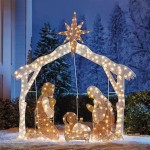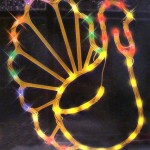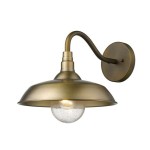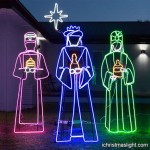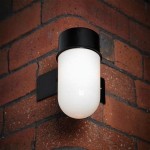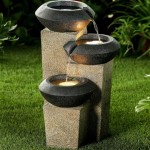Illuminating the Outdoors: Understanding Outdoor LED Lighting Systems
Outdoor LED lighting systems have revolutionized the way we illuminate exterior spaces. From residential gardens to expansive commercial properties, these systems offer a compelling blend of energy efficiency, longevity, and design versatility. Understanding the components, benefits, and applications of outdoor LED lighting is crucial for making informed decisions about lighting investments and creating safer, more aesthetically pleasing environments.
Traditional outdoor lighting options, such as incandescent and halogen lamps, are often energy-intensive and require frequent replacement. Conversely, LED (Light Emitting Diode) technology provides a significant reduction in energy consumption and extended lifespan, translating to lower operating costs and reduced maintenance requirements. Furthermore, LEDs offer greater control over light output, color temperature, and beam angles, providing enhanced design flexibility.
Outdoor LED lighting systems encompass a wide range of fixtures, each designed for specific purposes. These include landscape lighting, pathway lighting, security lighting, architectural lighting, and façade lighting. The selection of appropriate fixtures depends on the desired functionality, aesthetic goals, and the specific characteristics of the outdoor environment.
Key Advantages of Outdoor LED Lighting Systems
The adoption of outdoor LED lighting systems is driven by a multitude of advantages over conventional lighting technologies. These benefits extend beyond simple cost savings, impacting environmental sustainability and overall user experience.
Energy Efficiency: LED technology is inherently energy-efficient, converting a significantly higher percentage of electrical energy into light compared to incandescent or halogen lamps. This translates to substantial reductions in electricity consumption, leading to lower energy bills and a smaller carbon footprint. The energy efficiency of LEDs also reduces the strain on the electrical grid, contributing to a more sustainable energy system.
Longevity: LED fixtures boast an exceptionally long lifespan, often lasting tens of thousands of hours. This significantly reduces the frequency of replacements, minimizing maintenance costs and associated labor. The extended lifespan also minimizes disruption to outdoor spaces, as fixture replacements require access and potential disturbance to landscaping or surrounding areas.
Durability and Reliability: Outdoor LED lighting systems are designed to withstand harsh environmental conditions, including extreme temperatures, moisture, and physical impact. Solid-state construction eliminates fragile filaments or glass components, making LEDs more resistant to damage and ensuring reliable performance even in challenging outdoor environments. This durability is particularly important in areas prone to vandalism or severe weather events.
Design Flexibility: LED technology offers unparalleled design flexibility, allowing for precise control over light output, color temperature, and beam angles. This enables the creation of customized lighting solutions tailored to specific aesthetic goals and functional requirements. LEDs can be easily integrated into a variety of fixture designs, from minimalist spotlights to ornate architectural features.
Instant On/Off: Unlike some traditional lighting technologies, LEDs reach full brightness instantaneously upon activation. This eliminates the warm-up time often associated with other types of lamps, improving visibility and safety in critical areas. The instant on/off capability is particularly beneficial for security lighting applications, where immediate illumination is essential.
Environmentally Friendly: LED lighting is an environmentally responsible choice due to its energy efficiency and long lifespan. Reduced energy consumption translates to lower greenhouse gas emissions, while the long lifespan minimizes waste from frequent replacements. Furthermore, LEDs do not contain harmful substances such as mercury, which are present in some other types of lamps.
Components of a Typical Outdoor LED Lighting System
An outdoor LED lighting system comprises several key components that work together to provide efficient and reliable illumination. Understanding these components is essential for designing, installing, and maintaining an effective system.
LED Fixtures: These are the fundamental light-emitting units of the system. LED fixtures are available in a vast array of designs, sizes, and shapes to suit various applications. They incorporate LEDs, optics, and heat sinks to optimize light output and dissipate heat, ensuring long-term performance. The choice of fixture depends on the desired lighting effect, the area to be illuminated, and the surrounding aesthetics.
LED Drivers: LED drivers regulate the electrical current supplied to the LEDs, ensuring stable and consistent light output. They convert AC power to the low-voltage DC power required by LEDs. Selecting the appropriate LED driver is crucial for proper operation and extended lifespan of the LED fixtures. Drivers should be chosen based on the voltage and current requirements of the LEDs, as well as the operating environment.
Power Supply: The power supply provides the main source of electricity for the entire system. It converts the incoming AC voltage to the appropriate voltage required by the LED drivers. The power supply must be adequately sized to handle the total power consumption of all the LED fixtures in the system. Overloading the power supply can lead to reduced performance and premature failure.
Wiring and Cabling: Proper wiring and cabling are essential for ensuring safe and reliable operation of the outdoor LED lighting system. Wires and cables must be rated for outdoor use and protected from moisture, UV radiation, and physical damage. In addition, wiring connections should be properly sealed to prevent corrosion and ensure long-term reliability. Wiring must adhere to all local electrical codes and regulations.
Control Systems: Control systems allow for dimming, scheduling, and other advanced lighting control features. These systems can range from simple on/off switches to sophisticated automated lighting control systems. Control systems can enhance energy efficiency and improve the overall user experience. Some control systems can also be integrated with other smart home or building automation systems.
Mounting Hardware: Secure and appropriate mounting hardware is critical for ensuring the stability and longevity of the lighting system. Mounting options vary depending on the type of fixture and the surface to which it is being attached. Considerations should be given to wind load, vibration, and potential for vandalism when selecting mounting hardware.
Applications of Outdoor LED Lighting Systems
The versatility of outdoor LED lighting systems makes them suitable for a wide range of applications, from enhancing residential landscapes to illuminating large commercial properties.
Landscape Lighting: LED landscape lighting enhances the beauty and functionality of gardens, lawns, and other outdoor spaces. Spotlights, pathway lights, and well lights can be strategically placed to highlight architectural features, illuminate walkways, and create inviting outdoor living areas. Low-voltage LED landscape lighting systems are particularly popular due to their ease of installation and safety.
Pathway Lighting: Pathway lighting provides safe and secure navigation along walkways, driveways, and other outdoor paths. LED pathway lights offer efficient and durable illumination, improving visibility and preventing accidents. Careful consideration should be given to the spacing and height of pathway lights to ensure adequate illumination without creating glare.
Security Lighting: Security lighting deters crime and enhances safety around residential and commercial properties. Motion-activated LED floodlights provide bright, instant-on illumination when triggered by movement, alerting occupants and deterring potential intruders. Security lighting should be positioned to eliminate dark areas and maximize visibility.
Architectural Lighting: Architectural lighting accentuates the architectural features of buildings and structures, creating visually appealing nighttime environments. LED spotlights, wall washers, and uplights can be used to highlight facades, columns, and other architectural details. Architectural lighting can enhance the aesthetic appeal of buildings and create a sense of place.
Façade Lighting: Façade lighting is a specific type of architectural lighting that focuses on illuminating the exterior surfaces of buildings. LED façade lighting can be used to create dramatic lighting effects, highlight details, and enhance the overall appearance of a building. Façade lighting can be used to project corporate branding, or just add visual aesthetic to the external facade.
Signage Lighting: Outdoor LED lighting systems are widely used for illuminating signs and billboards. LED sign lighting offers efficient and uniform illumination, ensuring that signs are easily visible day and night. LED lighting is also energy efficient to prevent costly repairs and replacements.
Floodlighting: Floodlighting provides wide-area illumination for parking lots, sports fields, and other large outdoor spaces. LED floodlights offer high light output and efficient energy consumption, making them an ideal choice for these applications. Lighting must be proper and bright enough to offer full visibility to all persons using.
In conclusion, outdoor LED lighting systems offer a compelling combination of energy efficiency, longevity, and design flexibility. Their widespread adoption is transforming the way we illuminate outdoor spaces, creating safer, more aesthetically pleasing, and environmentally sustainable environments. By understanding the components, benefits, and applications of outdoor LED lighting, individuals and organizations can make informed decisions about lighting investments and create outdoor spaces that meet their specific needs and goals.

Outdoor Led Lighting Ideas For Any Style Backyard

Can Led Lights Be Used Outdoors Bpm Electric

Outdoor Led Lighting Exterior Light Fixtures E Conolight

Color Changing Waterproof Strip Lights For Outdoor Landscape Lighting

Outdoor Wall Lights And Sconces Elvi Home

The 3 Best Smart Outdoor Lights For Backyards Of 2024 Reviews By Wirecutter

The Advantages Of Outdoor Led Lighting

Exterior Wall Lights At Light11 Eu

Taking Your Outdoor Lighting To Another Level With Dynamic Led Lights Inaray Design Group

Outdoor Led Soffit Lighting Astoria Co
